Australia’s magnificent Barossa: Ultra old vine wines and the cream of Langton’s Classification
April 28, 2013

Tasting the "rare and distinguished" Barossa wines: 24 March 2013 in Düsseldorf (photo courtesy of Feodora Curtius)
One of many surprises whilst enjoying the great privilege of a dinner featuring 23 of the 123 “Langston’s classified wines” from Australia came from a marvelous Riesling. Another – far more profound – was discovering a wine that could be called the Petrus of Australia.
Of course the majority of these wines – all from the mythical Barossa region – were red. And while some did illustrate the cliché of over the top alcoholic bombs, many exuded balance as well as flavor. Some were downright elegant, with one particular wine proving to count among the most gracefully elegant I have ever tasted, period. For the tasting note, click here.
The occasion was a special dinner, hosted for a group of lucky wine writers, by the friendly and knowledgeable James March, CEO of the Barossa Grape & Wine Association. He and Matthew McCulloch, General Manager at Chateau Tanunda and Chairman of the Barossa Grape and Wine Association, guided 25 participants through 23 wines, before enjoying a lovely dinner in Düsseldorf during the week of ProWein. In addition, they both presented 8 additional very special old vine wines the afternoon before the dinner.
Below, March explains why he brought so many great wines to be tasted in Germany…
INTRO / 8 SUPER OLD VINE WINES / LANGTON’S TOP 23 OF BAROSSA / DETAILED TASTING NOTES
Heartfelt thanks go to Feodora and Thomas Curtius for their kind invitation to both the afternoon and evening tastings and to the ensuing dinner of 24 March 2012, which opened my eyes to the substantial high quality of the very best wines of Barossa: Count me among the guilty who have pre-judged Australian wines as fruit bombs: overblown alcohol rich and something more akin to coating your morning toast than to drinking.
These feelings are now dispelled. OK, some of the wines I tried were pretty “large scaled” – and I would have found them easier to enjoy on their own, rather than with dinner. They were not exactly like Italian wines, for example, which, showcasing more acidity, prove better matched for food.
But any dismissive notions of Australia as merely big and brawny have gone far away from my wine world-view, thanks to Thomas and Feodora. Their invitation helped me and others furthermore to understand that “Australia” is a bit of a misnomer. You can fit all of Europe into Australia, so imagine the different climates and microclimates one can encounter, from Tasmania to Perth.
Master Class: Among the oldest vineyards in the world, in Australia
Barossa is extra special, a region that resonates among wine lovers around the world. Comprised as it is of the Barossa Valley and its elevated, beautiful high country – the Eden Valley – the region is home to many of the oldest vineyards in the world. Yes, in the world. Some are over 160 years old. So the master class of 8 wines during ProWein (again, thanks to Fea and Thomas) of old vine Barossa wines, included such wines as the 166-year-old Schild Estate Moorooroo Limited Release Shiraz (2008 vintage), which, although, very rich, with a baked fruit aspect, certainly impressed my palate with its intensity of flavor. And I love the name! Just the idea of drinking wine made from such old vines proved exciting.
We also tasted wine from the 170-year-old Langmeil The Freedom Shiraz 1843 (so-named because it dates from that year). Its aromas leaped out of the glass, although a touch of volatility and over-the-top richness made me like the Moorooroo more. Others, coming from vines not quite as old, I actually preferred – see notes below. The bottom line: the wines not only impressed me with their history, and, well, bigness, but also some conveyed fine balance and two in particular pleased my palate with their poise. Readers take note: I am an Old World wine drinker, so I am not used to the Australian, er, scale here…
Wines in bold I liked in particular, red and bold even more, and when underlined, the most!
Yalumba Single Site Vine Vale Barossa Grenache, Barossa 2006: At 14.5% alcohol, this wine had a “pungent” nose and a color that was already showing some evolution. Very “leggy” – lots of glycerine here. Made from 64-year-old vines. I was not really enjoying this…
Cirillo Estate 1850 Old Vine Grenache, Barossa Valley 2008: Just 100 meters away, on similar sandy soils, this wine illustrates how important old vines can be for wine. A far less pungent nose, more interesting, more complex. There was on the palate a feeling of asphalt – just a bit of “road kill” and the alcohol was felt, at 14.6%. For about $70 Australian, I would not buy this, but it impressed many palates.
Hewitson Old Garden Mourvedre Barossa Valley 2010: Color here is more intense, darker core. It is the grape of course. Intense fruit, far less pungent than either of the above, with pure dark blackberry aromas – and even a fine mineral aspect with some seashell freshness. At 14.5% alcohol, far better integration. No signs of heat. Great stuff!
Poonawatta Estate The 1880 Shiraz, Eden Valley 2008: Talk about black ink! It has a jammy viscous oil like look. Made from vines grown on poor rocky soils. The taste was like the icing from a dark chocolate cake. Some real decadence here. Tasty, to be sure, but I am not sure this is really my style of wine! Still, I can see this making lots of people very happy. 15% alcohol…
Chateau Tanunda The Chateau Shiraz, Barossa 2010: The only wine here that is not coming from a single vineyard. Plum like, deep aromatics – host James March said that 2010 was a “stunning” vintage here – with a fine peppery aspect. I rather liked this wine.
Peter Lehmann Wines VSV 1885 Shiraz, Barossa 2009: This comes from 128-year-old vines and is a “very special vineyard,” March said. It costs $100 Australian. It exudes a cinnamon spice, and is quite smooth and elegant on the palate, albeit with a bit of a “sweet” factor. Overall, I really liked this one!
Schild Estate Moorooroo Limited Release Shiraz, Barossa Valley 2008: This also excited me. Coming from 166-year-old vines, made on sandy loam over clay, it had an intense nose, almost baked fruit aromas and on the palate, somewhat viscous and a bit warm, but pleasing.
Langmeil The Freedom 1843 Shiraz, Barossa Valley 2010: The oldest vineyard – 170 years old – and the wine was very bold, but it had a touch of volatile, to my senses. Some asphalt road kill like aspects. But big and bold to be sure, and lovers of the style will find their nirvana here!
I learned a lot from this tasting, and even more from the dinner tasting, see below, which featured the 23 Barosssa “rare and distinguished” wines listed in the 2010 Langton Classification.
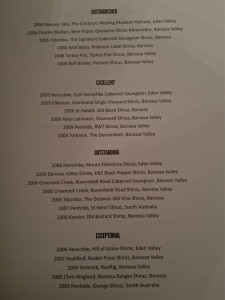
The cream of the Barosssa crop, according to Langton's Classification (click twice for a larger image)
Langton’s is Australia’s most famous wine auction house. Established in 1988 by Stewart Langton in response to a growing Australian interest in collecting fine and rare wine, the auction house has since then developed a thriving wine market for Australian and imported wine.
Followed by wine collectors and the wine trade around the world, the Langton’s Classification has become an Australian institution with a prestigious international currency. It is arguably the most famous and widely respected wine Classification outside of Europe.
Langton’s Classification of Australian Wine has achieved recognition because the criteria for inclusion are objective and market-driven and the Classification is regularly revised and updated. The fifth edition of the Classification, released in 2010, reflects a new confidence in quality Australian wine.
The 2010 edition comprises 123 top Australian wines, divided into categories of ascending value from (1) distinguished, (2) excellent, (3) outstanding and (4) exceptional.
You can go right to the tasting notes according to category: “DISTINGUISHED” / “EXCELLENT” / “OUTSTANDING” / “EXCEPTIONAL”
As we have discovered that Barossa is home to many of the oldest vineyards in the world, it comes as no surprise that many of the classified wines are found in this region. Shiraz is Barossa’s signature wine and is the most widely planted variety in the region. Of the 123 Langton’s Classified wines in 2010, 23 are made with Barossa fruit. A further four wines – including the legendary Penfolds Grange – are made with a significant proportion of Barossa fruit.
In his introduction to the tasting just before dinner, James March stressed that the wines were in some ways “coming home” because the of Barossa’s strong European influence, with many German families having founded some of the very top wines.
Indeed, Barossa can certainly boast a unique cultural heritage – itself an intriguing blend of Prussian, Irish, Scottish and English diaspora – as well as an acknowledged contribution to such recognized fine wine legends as Penfolds’ famous triumvirate of Grange, St Henri and RWT (Red Wine Trial); Stephen and Prue Henschke’s Hill of Grace (perhaps my overall favorite of all the wines we had tasted – and later, thankfully, drank); the tapestry of growers’ blend that makes up Stonewell from Peter Lehmann; and the audacity of Torbreck’s individual Shiraz crus, to name but a few.
A closer look at the region reveals that Barossa’s wide portfolio of varietals, blends, estates, single-vineyards and flagship releases makes it Australia’s “blue chip” wine region.
While Shiraz dominates the conversation in terms of price, presence and profile, old vine Grenache – whether as a stand-alone, or as part of the regional trinity of Grenache, Shiraz and Mataro (Mourvedre) – is another unique and treasured resource, as well as the ‘angel’s visit’ rarity of great Cabernet Sauvignon, often restricted only to particular vineyard sites – Penfolds’ Block 42, or Elderton’s Ashmead Single Vineyard – but still an important fine wine contribution to be reckoned with.
The story is not just about red, however. The Pewsey Vale, The Contours Riesling Museum Release, Eden Valley 2006 we tried even impressed many German palates, understandably proud of the great Rieslings produced in Germany. Part of the “distinguished” category, the wine is released only after five years of bottle age, and tasted very fresh. According to the guide we all received for the dinner tasting, the wine is “typified by lemon curd, white peach, herb garden, oil skin aromas, a natural mineral character and creamy flavors.” Its compelling ‘width and softness’ is central to the style.” I certainly detected a creamy richness with a fine line of acidity. Not as vivacious as, say, a Nierstein Riesling, but it was not the big fruit bomb I was expecting. Score some points for Aussie Riesling!
We then enjoyed a series of reds, in the ascending order from “distinguished” to “excellent” to “outstanding” to “exceptional”. Now, to be honest, I did not like all of them (again, my palate is accustomed to more restrained Old World styles) but I respected all of them, to be sure. And several proved quite astounding.
It makes sense. In the Old World, terroir is held in high esteem. But the reader and wine lover should know that since its beginnings in 1842, Barossa has attracted more international wine awards and more wine collector dollars than any other Australian wine region. The region boasts a generational culture of wine, the aforementioned pioneering European influence, gastronomic excellence and strong community spirit. It is almost 2,000 square kilometres in size and encompasses the Barossa Valley and its elevated, beautiful high country, Eden Valley.
Its climate ranges from warm on the valley floor to cool at the higher altitudes in the hills surrounding the Valley. The region has a large diurnal temperature range, high maximum temperatures, high sunshine days and low humidity and rainfall. Eden Valley has an average altitude of around 500 metres. Overall growing season temperatures are significantly lower than those of the Barossa Valley, and the final stages of ripening and harvesting take place in much cooler conditions.
The wines from Langton’s Classification: each of the wines is introduced, based on a text that we received at the beginning of the tasting. I then add my own tasting notes. As always, wines in bold I liked in particular; in red and bold even more and, when underlined too, the most. Please note that WOTF is an abbreviation for Wine of the Flight…
You can go directly to the sub categories, too:
“DISTINGUISHED” / “EXCELLENT” / “OUTSTANDING” / “EXCEPTIONAL”
The “Distinguished” flight – six wines
Pewsey Vale, The Contours Riesling Museum Release, Eden Valley 2006 – WOTF
According to information provided by the organizers of the dinner, Pewsey Vale was first planted in 1841 by Joseph Gilbert (1800-1881). The origin of the earliest vines at Pewsey Vale, and the 1962 re-plantings can be attributed to the “rischling clones” brought to Australia by James Busby in 1832.
Sourced from a single contour-planted south-facing block, on sandy loams over clay, this classic bone-dry Eden Valley style is crushed, drained and cold vinified in stainless steel with neutral yeasts.
The Contours Riesling, released with five years bottle age, is typified by lemon curd, white peach, herb garden, oil skin aromas, a natural mineral character and creamy flavours. A compelling “width and softness” is central to the style.
I certainly enjoyed this wine’s rather youthful feel for a wine that was already over six years old. It conveyed fine freshness and rich flavor. Excellent!
2006 Charles Melton, Nine Popes Grenache Shiraz Mourvedre, Barossa Valley
The dry grown, low yielding mature vineyards (many over 80 years old) are scattered throughout the Barossa floor from Williamstown in the south to Ebenezer in the north. Whole bunch fermentation, open fermentation, pigeage and the use of indigenous yeasts are winemaking techniques used to increase blending options. The wine is matured in 25% new French and American oak which “gives a kiss rather than a thump” to the overall style.
Erroneously named after Châteauneuf-du-Pape, Nine Popes (first vintage 1988) has become the doyen of Australian Rhone-style blends. Typically it shows exotic musky, mulberry/plum gamey aromas and plenty of fruit sweetness – and in this evening’s tasting I also got fig like Christmas cake, with a fine sense of balance.
For me, a bit of asphalt on the nose, but also plum and spice. Although the claim is made that this resembles most the southern Rhone style, I did not understand that comparison so much. It is quite rich, and glossier than what you would get from, say, a Domaine de Pegau Reserve. But that is not to say that I did not like it. It is just a suggestion to enter the wine as a “pirate” in a Chateaneuf du Pape tasting does not seem to be appropriate.
2006 Yalumba, The Signature Cabernet Sauvignon Shiraz, Barossa
The Signature Cabernet Shiraz was first made in 1962. Its origins are linked with Yalumba’s Galway Vintage Claret of the 1950s. Each release is a “salute to an employee or person who has made a significant contribution to the culture and traditions of the company”.
The Cabernet and Shiraz grapes derive from old vine material in the Eden Valley and Barossa Valley. After batch vinification the wine completes fermentation in barrel, followed by maturation in Yalumba coopered new and seasoned American and French oak.
It is typified by rich plum/dark chocolate, paneforte aromas and flavours, dense chalky tannins, superb generosity of fruit and underlying savoury mocha oak.
Wow this was quite a rich wine, like a chocolate cake to me, especially compared to the preceding wine. I could find a place to drink this but probably not at the dinner table!
2004 Wolf Blass, Platinum Label Shiraz, Barossa
The highly-prized Platinum Label is a blend of selected Shiraz parcels from Barossa and Eden Valley vineyards. In keeping with the style, each parcel of fruit is batch-vinified and matured separately for around 20 months in new (up to 90%) and one year old French oak barriques.
The first vintages comprised some barrel fermentation components and a proportion of American oak. The transition to 100% French oak allows fruit complexity and vintage character to show through.
Platinum Label is a “generously proportioned wine with a dark chocolate/black berry/plum fruit profile, smooth chocolatey fine tannins, plenty of mid-palate richness and complemented by savoury mocha oak”.
Could well be, but, for me, so far this has the most viscous feel on the palate, with some heat and slight drying on the palate. Not sure I really liked this.
2006 Turkey Flat, Turkey Flat Shiraz, Barossa Valley
The Shiraz vines at Turkey Flat Vineyards were first planted in 1847 by Johann Friedrich August Fiedler. Gottlieb Ernst Schulz, originally a butcher, purchased the mixed farming property in 1865.
Turkey Flat Shiraz derives from estate owned low-yielding vineyards of varying ages in sub-regions Bethany (including the original vineyard), Koonunga Hill and Stonewell. The wine is vinified in stainless steel fermenters followed by 22 months maturation in new and seasoned French oak hogsheads which adds “depth, length of flavour and textural support to the palate.”
According to the winery notes, Turkey Flat Shiraz is typified by “dark cherry/chocolatey aromas and flavours, ripe textured tannins, plenty of fruit sweetness, concentration and flavour length”.
I found this wine, certainly lighter in color, to be more subtle than the preceding Wolf Bass – and better. There is a marvelous German Blackforest cake aroma and flavor that make it very appealing. Bravo!
2009 Rolf Binder, Hanisch Shiraz, Barossa Valley
During the 1980s Rolf Binder observed that a 1.62 hectare section of the Hanisch vineyard, consistently yielded eight rows of Shiraz grapes with “intense aromas, deep colours and flavours”. The variable soils range from shallow gravelly sandy loams to ironstone and “Bay of Biscay” black soils.
After vinification maturation takes place for around 24 months in 80% new American and seasoned French oak. “Minimal handling, a hands on approach and attention to detail are paramount” to winemaking philosophy.
According to the guide, “these are impressively structured wines with beautiful dark chocolate/dark berry/plum fruit definition, superb concentration, ripe tannins, mocha oak and flavour length.”
I like the plum like fruit, rather intense dark fruit aspect overall, on the palate. Coming back to it, later, it seemed to have more of a sweet fruit aspect.
The “Excellent” flight – six wines
Before the tasting, we enjoyed a palate cleansing Jansz sparkling wine from Tasmania. It was dry yet fruity, and perfect for easy sipping. Wine Australia’s Yvonne May explains that it was served at Buckingham Palace and that “if it is good enough for the Queen, it’s good enough for us.” Rather!
“DISTINGUISHED” / “EXCELLENT” / “OUTSTANDING” / “EXCEPTIONAL”
2005 Henschke, Cyril Henschke Cabernet Sauvignon, Eden Valley
The late Cyril Henschke purchased this Eden Valley property in the 1960s. Stephen and Prue Henschke established the existing dry-grown single vineyard with Cabernet Sauvignon, Merlot and Cabernet Franc vines in 1988.
The north facing vineyard, farmed using organic and biodynamic principles, is planted on well-drained duplex soils; typically sandy loams over gravel and bedrock with patches of clay. After vinification in “headed down” open fermenters, the wine completes fermentation and is matured for 18 months in 100% new French oak.
According to the guide, “Cyril Henschke Cabernet is a very perfumed wine with intense pure blackcurrant cedar meaty characters, fine grained tannins and savoury/vanillin oak complexity.”
I liked this wine’s cooler aspects – compared to preceding wines – and found it very appealing.
2005 Elderton, Command Single Vineyard Shiraz, Barossa Valley
Elderton Command Shiraz is “classic old vine” Barossa Shiraz. The name was coined because the best fruit commanded special treatment. The wine derives from a single century-old vineyard located on the banks of the Para River. The wine is vinified in traditional “headed-down” open fermenters. Fermentation is completed in new French (35%) and American oak (65%) puncheons. After 12-18 months in these barrels, the wine is racked into older oak for a further 18 months.
The Command Shiraz, according to the guide, “is typified by raspberry/blackberry/dark chocolate/meaty/violet aromas and flavours, pronounced chalky firm tannin structures, mid-palate richness and underlying/integrated oak.”
I found this particular bottle to have a bit of volatile acidity, but – in the end it proved appealing, as it displayed fine concentration and richness without being cloying.
2006 St Hallett, Old Block Shiraz, Barossa
St Hallett Old Block derives from ‘old vine’ vineyards in the Barossa including the original Old Block Vineyard planted in 1912 and the sub regions of Seppeltsfield, Ebenezer, Moculta and Eden Valley. Typically these dry-farmed vines are around 60 to 110 years old. Nowadays the wine is matured in new and seasoned French oak; the proportions are entirely dependent on vintage conditions.
Once a “blockbuster” Barossa Shiraz of the old school, it has become – according to our guide – “more perfumed and elegantly proportioned with intense raspberry/dark berry/espresso aromas, blackberry/ dark chocolatey flavours, fine grained tannins and underlying savoury oak.”
I found some volatile here – nail polish aromas – that were a bit off putting at first, but they blew away with time. And there seems to be greater purity on the palate, more precision than the above wine.
2006 Peter Lehmann, Stonewell Shiraz, Barossa Valley
Immensely concentrated, low-yield fruit, combined with skilled winemaking, is the basis of this Australian Shiraz. The wine is derived from 20 ‘best of the best’ Shiraz vineyards of the vintage located in the drier sub-districts of the Barossa, including Stonewell (hence the name), Marananga, Greenock, Kalimna and Ebenezer. Eden Valley material can also be included in certain years. Peter Lehmann Stonewell Shiraz is a classical/modern style, barrel fermented in new French and American oak.
According to our guide, these wines show “plenty of paneforte/plum/chocolate aromas, voluminous sweet fruit, structured tannins, well-seasoned oak flavours and tremendous length.”
I liked the mint and freshness aspects, although was it just a touch drying on the finish, and that detracted for me.
2009 Penfolds, RWT Shiraz, Barossa Valley
Penfolds RWT Barossa Shiraz, first vintaged in 1997, was released after several years of Red Winemaking Trials. The fruit is drawn from mature (20 to 100 year old) vineyards located in the west, north-west and central-west Barossa Valley around Kalimna, Moppa and Ebenezer, Stonewell, Marananga and Seppeltsfield. The wine is batch-vinified in headed-down open stainless steel fermenters and then racked into new tightly grained French oak to complete fermentation. It is then matured in new and seasoned French oak for around 12 to 15 months.
RWT Barossa Shiraz, according to our guide, is an “opulent powerful wine with sumptuous fruit sweetness, underlying spice/savoury nuances and chocolatey tannins”.
Like all the other Penfolds tasted this evening, I liked this one – although perhaps the least. It was certainly very rich, but I could sense still the oak and a touch of heat.
2004 Torbreck, The Descendant, Barossa Valley – WOTF
Descendant Shiraz Viognier is “a direct Descendant of the RunRig and the two are inherently linked”. Co-fermentation of Shiraz and Viognier (typically 8%) is very much central to winemaking philosophy. The fruit derives from the 4.4 hectare Descendant Block Vineyard located on Roennfeldt Road at Marananga in the Barossa Valley. The co-fermentation effect combined with traditional vinification in open fermenters results in wines of extraordinary colour, aromatics, texture and flavour. The wine is matured into “two-and-half year-old RunRig wine-seasoned” barriques for around 18 months.
According to the information we had received, Descendant Shiraz Viognier is characterised by “intense violet/blackberry/apricot/aniseed aromas, rich flavours and chocolatey dry tannins.”
My favorite of this flight, and perhaps so far amongst all the reds. Lovely aniseed notes, full of flavor, with a certain floral aspect – and fine balance among alcohol, tannin and acidity. Very nice job!
The “Outstanding flight” – seven wines
“DISTINGUISHED” / “EXCELLENT” / “OUTSTANDING” / “EXCEPTIONAL”
2006 Henschke, Mount Edelstone Shiraz, Eden Valley
Planted in 1912 this isolated Shiraz vineyard came of age long before the golden age of Barossa Shiraz. In 1952 it was already a mature single vineyard intertwined and connected to the Eden Valley landscape. Planted on their own roots on fine sandy loams over deep gravely medium red clays, the mature vines are dry grown and yield an average of around four tonnes per hectare. Organic and biodynamic principles to “drought proof the vineyard and optimize soil and vine health” are now widely practiced.
The wine is vinified in “headed-down” open fermenters and then completes fermentation in a combination of 90% new and 10% seasoned French (about 65%) and American (about 35%) hogsheads. It matures for a further 20 to 22 months in the same oak prior to blending and bottling.
According to the information from Langton’s, Mount Edelstone Shiraz, with its contrasting light, shade, flaws and perfection, evokes “the magical puissance of vineyard provenance and the mood of nature and nurture.” Its “pure blackberry/ sage aromas, underlying savoury complexity and fine lacy tannins” lead to “optimum maturity after around five to 15 years, and the very best vintages have greater lasting power.”
What I really liked about this wine was a certain mint like freshness, with somewhat intriguing herbal notes that complemented its evident richness. A very fine wine, and a nice way to begin the flight!
2006 Barossa Valley Estate, E&E Black Pepper Shiraz, Barossa Valley
Originally conceived by veteran winemaker Colin Glaetzer, this wine is sourced from classic dry grown low-yielding vineyards in the northern Barossa Valley. The vines are located on undulating slopes and flats comprising deep sandy loams and rich red-brown clay soils. This traditional multi-vineyard style, comprising as many as ten blocks, is based on the best available fruit; typically highly concentrated and intensely flavored.
The wine is batch-vinified in the traditional style. Many parcels are open fermented. At completion of vinification the wines are drained and pressed off into an equal combination of new and seasoned American and French oak barriques and hogsheads (of which roughly 30% is new) for between 12 and 18 months (the proportions and time dependant on the character of the wine).
E&E Black Pepper Shiraz is considered a “benchmark” Barossa Shiraz with its plush dark fruit and licorice, ripe tannins, mid-palate richness and underlying oak. With all the structural attributes for medium to long term cellaring, it has very strong and consistent currency in the secondary market. The wine is released into the primary market with around 4-5 years bottle age.
For me, this wine, on one level, aromatically, perhaps more subtle than the above, even a touch closed on the nose. But very revealing on the palate – illustrating a rather “high octane” style – the wine displays much licorice, dark blackberry fruit, with a malty oak derivation that is not too imposing. Darn good.
2006 Greenock Creek, Roennfeldt Road Cabernet Sauvignon, Barossa Valley
Michael Waugh, a former builder and stone mason, is responsible for re-building or extending some of the region’s best known cellars, including Rockford and Henschke. Initially a very limited-production wine was made with the help of Chris Ringland, then winemaker at Rockford, in the cupboard-sized 19th century cellars underneath the 160 year-old stone-built homestead. Early recognition by international wine critics lead to new cellars, complete with traditional open fermenters, being built at Roennfeldt Road. The overarching philosophy is “to make the best possible wine from our estate grown grapes”.
Greenock Creek Roennfeldt Road Cabernet Sauvignon is derived from a vineyard planted during the 1930s. Anchored in heavy red loams and clay, the Cabernet Sauvignon vines are some of the oldest in the region. At optimum ripeness the Cabernet Sauvignon is vinified in open fermenters at around 18-20°C. Maturation takes place for around 36 months in a combination of 10% new and 90% seasoned French oak hogsheads, coopered by AP John.
Winemaker Michael Waugh, largely self-trained, has a fairly “laissez-faire” attitude to barrel maturation; bunged at 1 o’clock they are rarely topped up for three years. Hands-on, intuitive and creative he epitomises the artfulness of winemaking in the Barossa. With only two or three barrels made each year the “opulently structured and chocolatey” Roennfeldt Road Cabernet Sauvignon is extremely limited. In past years it has fuelled a ‘cult-psychology’ among buyers.
Be that as it may, this wine counts among my least preferable wines of the tasting, because it seemed as if the elements were out of whack, disjointed. I could sense acidity on one level, and sweetness on another. There was an aggressive nature to the palate that I did not like – and the alcohol was a hefty 16%!
2006 Greenock Creek, Roennfeldt Road Shiraz, Barossa Valley
According to the information provided, scarcity and 100-point scores from American critic Robert Parker Jr. have led to an impressive wine market following. While still lying at the cusp of the cult wine market, Greenock Creek Roennfeldt Road Shiraz is a “unique and convincing translation of the Barossa vernacular”.
Whatever the point scores from the Almighty One, even more alcohol here, close to 17% … I certainly got the feeling of icing on the cake like texture that was, for my palate, over the top. But I could see how it would please some palates. I could not imagine drinking more than a glass, before risking blackout conditions… The aromas however – intense dark fruit, dark espresso, chocolate like icing on a chocolate cake – were very intense.
2006 Yalumba, The Octavius Old Vine Shiraz, Barossa
Established in the mid 19th century by Samuel Smith. Descendant Robert Hill Smith now presides over Australia’s oldest family wine company. Aptly described as “remarkably individual and generous,” the Octavius Old Vine Shiraz is made from a selection of aged Shiraz vineyards scattered across the Barossa region. Most were planted as bush vines between the turn of the century and World War Two. The oldest vineyard was planted in 1901. Yields are between two and five tonnes per hectare. Soil types vary from red-brown earth over red clay, sandy loam over clay to sandy soils.
Vinification takes place in six- to eight-ton open top stainless steel fermenters. Fermentation is completed in new and seasoned French oak. It was originally aged in small American oak octaves (around 80 litres). Nowadays maturation takes place in Yalumba-coopered octaves, barriques and hogsheads for around 22 months. The proportions of size, new and seasoned oak is dependent on the intensity, concentration and character of the wine.
According to information supplied for the tasting, this wine “combines the perfume and pure fruit aromas of the Eden Valley subregion and the concentration, texture and ripeness of Barossa Valley Shiraz.”
Here we go back to a wine that is indeed more interesting, more subtle and authentic. The nose is not evident at first, needs time to open up – in spite of the fact that the wine was decanted. Aromas slowly yield dark chocolate and brambly dark fruit. The palate features tannins silky and elegant with flavors that are rich, yes, but not hitting you over the head. A very successful wine.
2007 Penfolds, St Henri Shiraz, South Australia – WOTF
Penfolds St Henri is one of Australia’s greatest red wines with a compelling history and heritage. The wine, first made in 1953, is often seen as a “foil” to Grange. The ‘claret’ style was developed by winemaker John Davoren (1915-1991) at the now defunct Auldana Cellars and Vineyards, purchased by Penfolds in 1943. Nowadays St Henri is a multi-district blend drawing Shiraz from the Barossa Valley, Eden Valley, McLaren Vale, Clare Valley and Langhorne Creek. The Adelaide foothills is now making significant contributions to the blend. A smaller proportion of Cabernet Sauvignon is sourced from the Barossa Valley, Coonawarra and Bordertown.
Every parcel is batch-fermented in headed down stainless steel tanks at Nuriootpa and open fermenters at Magill. Each component is classified according to fruit profile and structure. The young wines, which make “the cut”, are matured for between 15 and 18 months in large 1460-liter old oak casks. Over this period, the fruit builds up further complexity and richness while the tannins soften and develop.
I would agree with the description provided in that this wine is at once refined in terms of a “lacy firm grained palate texture” combined with underlying power. It is said that the best vintages will evolve for “up to 30 years and sometimes even further”. Penfolds St Henri is based on fruit definition and flavour, but the absence of new oak, so prevalent in contemporary Australian fine wine, sets it apart. The wine of the flight!
2009 Kaesler, Old Bastard Shiraz, Barossa Valley
Now, I cannot agree with the information provided that Kaesler Old Bastard Shiraz is “one of the Barossa’s most exquisite wines”. At least based on this tasting! It is more like its namesake… Anyway, based on a small patchwork of “old bastards”, planted around 1893 on sandy clay loams over clay, it captures the essence of contemporary Australian winemaking philosophy where individual vineyard site is the ascendant star. Roseworthy-trained winemaker Reid Bosward initiated a program of sustainable viticulture, and soil improvement to achieve natural equilibrium to the vines. According to information provided: “This work, together with imaginative winemaking, has resulted in a grand dividend. Kaesler Old Bastard Shiraz, with its distinctive Ralph Steadman caricature label, is a highly individual style with elegance of fruit, density and richness, savoury muscular tannins and underlying oak.”
The wine is fermented in stainless steel and matured in ‘Burgundian’ oak for 19 months. It is bottled “au naturel”, with no fining and filtration. The alcohols tend to hover around 15% to 16% …
A lot of people loved this, but it reminded me of an over alcoholic Saint Emilion from a recent vintage, where Merlot gets too high in alcohol. I just could feel the heat here and did not like it.
The “Exceptional” flight – five wines
“DISTINGUISHED” / “EXCELLENT” / “OUTSTANDING” / “EXCEPTIONAL”
2006 Henschke, Hill of Grace Shiraz, Eden Valley * – WOTF
This could be my favorite Australian wine I have ever tasted. Ever. That is what the asterisk is for…
According to information provided for this tasting, the “beautiful and ethereal Henschke Hill of Grace Shiraz, first vintaged in 1958, is Australia’s most famous single vineyard wine”. I can understand this. The evolution of wine style is inextricably intertwined with the flowering of the “Barossa aesthetic”. Prue and Stephen Henschke’s Hill of Grace is the “quintessential” Eden Valley Shiraz with its pristine blackberry pastille/sage aromas, mocha nuances, fine lacy tannins, voluminous freshness and underlying savoury oak. It has a compelling vinosity and singularity of voice; a scent of place that crescendos with age.
Just 8 hectares, the Hill of Grace Vineyard takes its name from the adjacent Gnadenberg Lutheran Church and lies at around 400m, and was originally planted during the 1860s by Nicolaus Stanitzki, a Henschke ancestor. The gnarled old Shiraz vines, “some of the world’s oldest genetic material”, are dry grown and trellised on a two-wire system. Organic and biodynamic principles are now employed to preserve soil moistures, optimise vine and soil health and “drought proof” the vineyard.
The vineyard is planted on red clay soils overlain by sandy and silty loams interspersed with gravels. The individual blocks are named after local landmarks and the remains of the 19th century Parrot Hill village. Several blocks are planted with “pre-phylloxera genetic material” brought out from Europe by early settlers. These include the surviving 1860s plantings known as Grandfather’s and Post Office Blocks One and Two. Church Block, House Block and Windmill Block, were planted with the same colonial vinestock, during the 1950s. Post Office Block Three was planted in 1989.
The highly refined, beautifully proportioned ‘Hill of Grace’ style speaks profoundly of place. Since 2002, Hill of Grace has reached another plane, the result of optimizing magnificent vineyard resources, superb technical skills and craftsmanship. Neither as powerful as Penfolds Grange, nor as densely rich as many Barossa Shirazes, it defines the Eden Valley Shiraz genre.
What can I say? A perfumed nose, with elegance and racy refinement. This was so non blockbuster material, it reminded me of a wine in the style of the very best from Moueix on the Right Bank: richness yet utter beauty and delicate flavors. The best of them all.
2002 Rockford, Basket Press Shiraz, Barossa Valley
According to information provided at the tasting, Robert O’Callaghan’s Rockford Basket Press Shiraz “encapsulates traditional and contemporary winemaking philosophies and embraces the inherent qualities of old vine Shiraz: the physicality of winemaking where muscle and personal touch transform process into an artform; the traditional tools of trade (a 1910 petrol-driven old Bagshaw crusher, basket press, open fermenters) and the complementary nuances of American and French oak maturation.”
Robert O’Callaghan is one of the most important figures in contemporary Australian winemaking. He early recognized the future of “regional definition” and the importance of heritage and the conservation of both physical and viticultural resources.
Chris Ringland, who worked at Rockford for around 18 years, said “working with Robert was to present an extraordinary opportunity in gaining an understanding of the traditional Australian wine trade. Just as he had learned the winemaking elements of previous generations, so we were to use the distillation of this experience in establishing winemaking philosophy at Rockford. The techniques were simple, the principles sound.”
The fruit, from 60-140 year-old vines, is sourced from local growers in the Barossa including around Kalimna, Ebenezer, Moppa Springs, the Eden Valley and Central Barossa giving fruit of tremendous colour, power and richness.
I indeed savored the ripe blackberry and chocolate fruit, underscored by seasoned American and French oak and ripe tannins. Balanced and conveying some freshness as well as fruit. But this wine paled in comparison to the Hill of Grace, lacking the latter’s incredible subtlety. Still, it counted among the red and bolds…
2004 Torbreck, RunRig, Barossa Valley
According to information provided for this tasting, the Torbreck RunRig Shiraz has earned a “remarkable reputation among collectors worldwide for its integrity, individuality, riot of aromas and voluptuous richness”.
Winemaker and founder Dave Powell is a scion of Robert O’Callaghan’s “Rockford School”. He established Torbreck through seeking out and improving some of the finest old Shiraz vineyard sites in the Barossa.
RunRig Shiraz, named after a Scottish distribution method of property, is derived from 8, 80- to 140-year-old dry grown vineyards mostly located on the north western fringe of the Barossa. The soils are primarily red brown loams with a high proportion of clay. All vineyards are either share-farmed, owned or under full vineyard management control. Typically the vines will crop at around two to four tons per hectare.
Traditional winemaking techniques comprising batch vinification in open concrete fermenters are combined with offbeat ideas about the effects of ultra-violet light, gravitational pull on polymerization of tannins, fermentation speeds and Baumé levels. Winemaking options, depending on vintage, may include pre-fermentation cold soak, extended maceration, partial whole bunch fermentation, warm and cooler ferment regimes and regular pumping over.
According to the experts, Run Rig is “opulent and sensuous with blackberry, musky violet aromas, dense supple, velvety tannins and underlying savoury oak”. I did get that as well, but this did not count among my most memorable wines of the tasting this evening. It was good, but not that great for my palate.
2005 Chris Ringland, Barossa Ranges Shiraz, Barossa
The information provided describes Chris Ringland Shiraz as “an utterly gorgeous wine that not only bombards and challenges the senses but suggests a deep emotional connection between the winemaker and his vineyard landscape”. Could well be; I certainly got the bit about “bombarding your senses…”
Ringland is a passionate proponent of Barossa Shiraz. He is very much a scion of Robert O’Callaghan’s ‘Rockford School’ where “meticulous order, accumulation of experience and creativity” underpin the winemaking philosophy.
Chris Ringland Shiraz is a small vinification of around four to five hogsheads or 1500 liters. The “unusually thick skinned” Shiraz is entirely sourced from Chris Ringland’s dry-grown vineyard on the edge of the Barossa Valley, but technically in Eden Valley, along Flaxman’s Valley near Randall’s Hill. The 1910 vines are planted in shallow skeletal granitic sandy loams over underlying clay moisture- holding podzols. On a clear day it is possible to see (by telescope!) the spire of Gnadenberg, the church that lies in front of the Hill of Grace Vineyard.
Ringland believes his century-old vines yield Shiraz of unique “lushness and tremendous concentration”. In some seasons the fruit will naturally ripen up to 17° Baumé yet retain excellent acid balance and flavour!
Ringland describes his wine as “a celebration of tiny parcels of true vineyard selected fruit”. The wines are “painstakingly hand-made” in open fermenters and regularly pumped-over “to extract color, flavor and tannins”. After draining and pressing through a traditional wooden basket press, fermentation is completed in 100% new French oak hogsheads. A period of up to 46 months oak maturation follows to achieve optimum complexity and balance between oak and fruit. During this period Chris Ringland generally leaves the barrels alone believing that a laissez-faire approach will allow the tannins and oak to harmonise into the “landscape of the wine”.
The extraordinarily high release prices (higher than Penfolds Grange), limited production and reputation have made Chris Ringland Shiraz a modern legend appealing to a very small but impressively supportive market.
This wine, overall, seemed aggressive to me, and the high alcohol came to the fore. I could not help but notice the near 18% alcohol – not a point in the wine’s favor. Still, it had much intensity of flavor and a very plush mouth feel. For lovers of this style, perhaps a nirvana wine? But for the money, I would steer (way) clear and opt for Hill of Grace or the final wine among the “the Exceptionals” …
2005 Penfolds, Grange Shiraz, South Australia
Penfolds Bin 95 Grange Shiraz is Australia’s “pre-eminent first growth”. Created in 1951, it marks the beginning of the modern Australian wine industry. The ideas and practices developed by Max Schubert and his team would irrevocably change the landscape of Australian wine.
Emerging from a fortified wine culture, the Penfolds House Style combined traditional winemaking practices with innovative processes of vinification and maturation. The “Penfolds method” has become a widespread Australian winemaking technique. The story of Grange mirrors the hopes and aspirations of post-war Australia; a country seeking to establish a new multicultural identity and confidence. For Australians, Penfolds Grange is more than just a wine. It represents an Australian aesthetic of “beauty, rich and rare”.
1951 Penfolds Grange Hermitage, the first vintage, was based on the 19th century “Grange Vineyard”, established in 1844, and Morphett Vale fruit. Both of these vineyards have since succumbed to Adelaide’s urban development. What remains of the old Grange vineyard, a mere 5.24 hectares, is now known as Magill Estate.
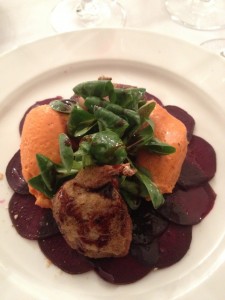
The rich finesse of roast quail breast with beets and yellow paprika mousse was matched very well by the Hill of Grace
Grange comprises a significant proportion of Barossa Shiraz, particularly from the Kalimna Vineyard, purchased by Penfolds in 1945. This vineyard has contributed fruit (except for 1957) since 1953. The ‘hidden’ 1957, 1958 and 1959 vintages were made without the knowledge of head office. Once revealed, Grange and Max Schubert became household names.
The wine, however, is invariably a multi-vineyard, multi-regional blend based on a warm-climate Shiraz fruit profile: dark chocolate/dark berry aromas, buoyant fruit and ripe dense tannins. McLaren Vale and Magill Estate contribute the balance of Shiraz; a small proportion of Coonawarra, Padthaway, Robe and Bordertown Cabernet Sauvignon may be included.
Penfolds Bin 95 Grange Shiraz is indeed perfumed, if not quite as exciting as the Hill of Grace; for me at least. However, it may have more concentration coming from the rich fruit and ripe tannin. Perhaps the King to the Hill of Grace’s Queen? The first time I have ever tasted this iconic wine – and I was indeed very impressed!

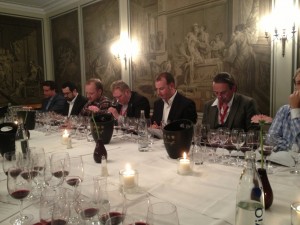
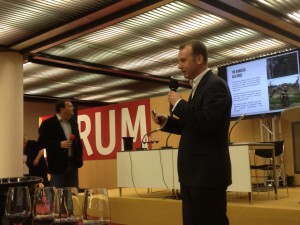
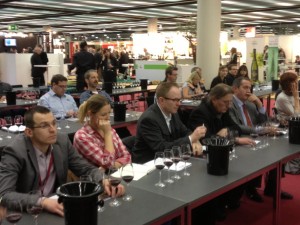
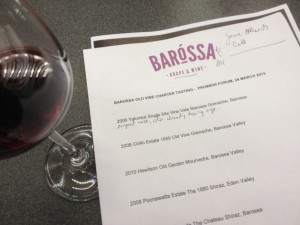
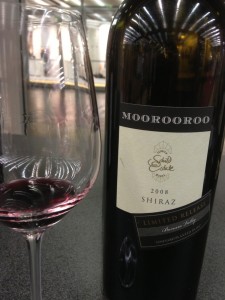


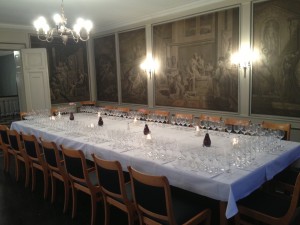
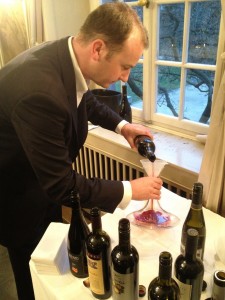
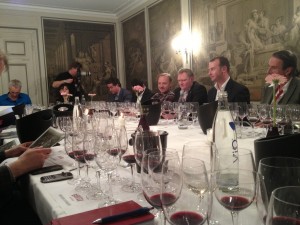
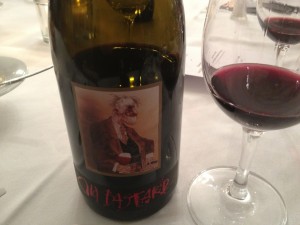
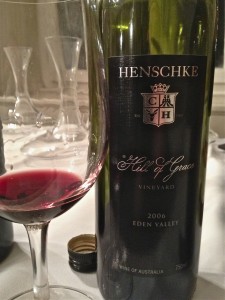
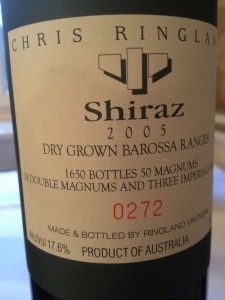
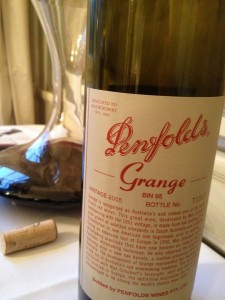
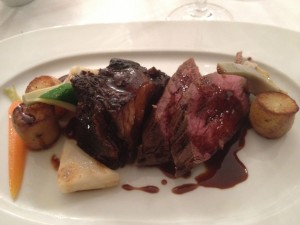
[…] Kakaviatos attends a magnificent tasting of wines from the Barossa. (0) Comments (function() { var po = […]